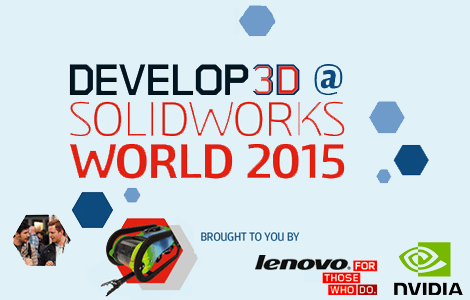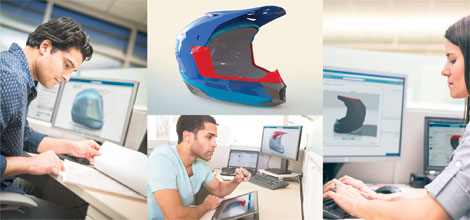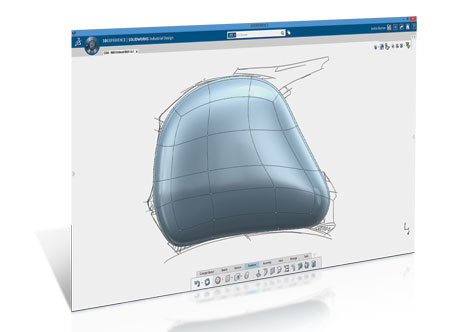
In front of 5,500 attendees at its SolidWorks World user event in Phoenix, new CEO Gian Paolo Bassi heralded the arrival of SolidWorks Industrial Design (SW-ID).
Representing the next generation SolidWorks tool, SW-ID is based on the 3DExperience platform of parent company Dassault Systèmes (DS), rather than the standard SolidWorks.
Previewed at SolidWorks World 2014 as Industrial Conceptual, SW-ID is billed as an ideation enabler, aiming to equip mechanical engineers with ‘product design’ tools, as well as enabling cloud-based workflows.

SolidWorks Industrial Design allows for cloud-based collaboration through a web browser-based interface
SW-ID is able to produce organic shapes and concepts by developing sketches, freeform Sub-D 3D modelling, feature-based and direct 3D modelling.
The big news is the cloud-based teamwork abilities, which allow users to collaborate through a web browser-based interface.
Designers can chat with other users, share models and annotate in real-time, using the cloud for model sharing and modifications (using save and refresh).
With control locking, individual users can be assigned responsibility for updating the model.
Also new are the pen-based sketch controls. Product demos at SolidWorks World showed SW-ID working with a Wacom Cintiq multi-touch, reproducing a pen and paper environment for fast concept sketching.
Sketch options come complete with Photoshop-style shortcuts – hitting the shift key to instantly straighten hand drawn lines, and ‘alt’ to curve them.

Product demos at SolidWorks World showed SW-ID working with a Wacom Cintiq multi-touch, reproducing a pen and paper environment for fast concept sketching
The sketches look similar to Catia Natural Sketch and Catia’s Imagine & Shape modules, working on 3D planes (front, top, side) that can continue to be developed as 3D models within the SW-ID 3D modelling tools.
This model can be built out using the 3D modelling tools, including SolidWorks’ own proprietary Sub-D system. However, with a focus on A-Surface development, exterior surfaces still need to be turned into engineered components so models will need to be exported to traditional SolidWorks for further development.
How design changes can be accommodated is, as yet, unclear.
“The needs of the CAD user community have been a beacon of technological innovation and we are committed to developing tools that respond to evolutions in the product design process, from a technical perspective as well as a collaborative one,” said Gian Paolo Bassi, CEO, SolidWorks.
“With SolidWorks Industrial Design and our 3DExperience platform, we want engineers to be able to rely on powerful, accessible technologies that facilitate their work and result in significant business advantages.”
SW-ID is the second SolidWorks application to be delivered on DS’ 3DExperience platform, after SolidWorks Mechanical Conceptual was launched two years ago.
The product will cost $190 per month (£145 suggested UK price) with a 12-month commitment when it launches in April this year.
For standard SolidWorks, also announced was SolidWorks Model Based Definition (MBD) for streamlining the generation and use of engineering documents using a 3D annotation (or Product Manufacturing Approach/PMI) approach that is typically found in higher-end, enterprise level systems.
MBD allows users to generate one master document for all product and manufacturing information, downstream processes, and compliance with regulations and standards without having to produce and maintain separate sets of 2D engineering drawings.
Engineers can define, organise and publish product and manufacturing information directly in 3D (and associatively to the 3D model) with a view to improving communication between design and manufacturing teams and reducing the risk of errors.

Concepts can be built out using the 3D modelling tools, including SolidWorks’ own proprietary Sub-D system
Analysis
SW-ID is the realisation that the worlds of designer and engineer are fast combining, but it’s a shame that DS is still insisting that the two disciplines are distinct and separate.
While a bifurcation of roles may be true in automotive firms and enterprises, for traditional SolidWorks customers it is uncommon for it to exist in any rigid form.
Every sound bite at SWW was about the age of the entrepreneur and enabling fast, fluid, collaborative design. Perhaps now DS is understanding that tools for this new era of design are needed fast.
What has really grabbed the headlines is the move to the cloud using DS’ 3DExperience platform. While cloud-based product development tools are still in their infancy, the launch of Autodesk Fusion and the soon to be unveiled Onshape shows that momentum is growing.
Price has also raised some eyebrows, for what is essentially an ‘add-on product’ that has limited interoperability with the familiar desktop SolidWorks (due to the two products being based on different foundation technologies).
In terms of modelling functionality, there appear to be many similarities with Autodesk Fusion and Rhino. However, SW-ID is comparatively expensive, especially when hitched to the standard SolidWorks product.
This is the first round in the battle for the next generation of MCAD systems and excitingly, there’s still a long way to go.

SolidWorks CEO helps out DEVELOP3D’s game of #SWWBingo by dressing up as a cowboy on the main stage
Catch up with all the action from DEVELOP3D’s blog from each day of SolidWorks World 2015, here and as it happened:
Day Two – Moon landings with SolidWorks; keynote from Dr Michio Kaku; encouraging female engineers







